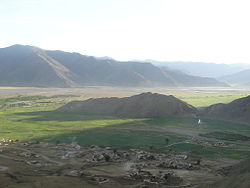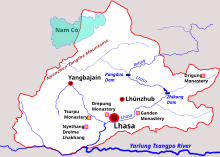
The Brahmaputra, also known as the Yarlung Tsangpo in Tibet, the Siang/Dihang River in Arunachal Pradesh, and Luit in Assamese, is a trans-boundary river which flows through Tibet, China, India, and Bangladesh. It is the 9th largest river in the world by discharge, and the 15th longest.

Lhasa is the urban center of the prefecture-level Lhasa City and the administrative capital of Tibet Autonomous Region in Southwest China. The inner urban area of Lhasa City is equivalent to the administrative borders of Chengguan District, which is part of the wider prefectural Lhasa City.

The Yarlung Tsangpo Grand Canyon, also known as the Yarlung Zangbo Grand Canyon, the Tsangpo Canyon, the Brahmaputra Canyon or the Tsangpo Gorge, is a canyon along the Yarlung Tsangpo River in Tibet Autonomous Region, China. It is the deepest canyon in the world, and at 504.6 kilometres (313.5 mi) is slightly longer than the Grand Canyon in the United States, making it one of the world's largest. The Yarlung Tsangpo originates near Mount Kailash and runs east for about 1,700 kilometres (1,100 mi), draining a northern section of the Himalayas before it enters the gorge just downstream of Pei, Tibet, near the settlement of Zhibe. The canyon has a length of about 240 kilometres (150 mi) as the gorge bends around Mount Namcha Barwa and cuts its way through the eastern Himalayan range. Its waters drop from about 2,900 metres (9,500 ft) near Pei to about 1,500 metres (4,900 ft) at the end of the Upper Gorge where the Po Tsangpo River enters. The river continues through the Lower Gorge to the Indian border at an elevation of 660 metres (2,170 ft). The river then enters Arunachal Pradesh and eventually becomes the Brahmaputra.

Lhünzhub County, also called Lhundrub or Linzhou County, is a county in Lhasa towards the north-east of the main center of Chengguan, Tibet, China. It covers an area of 4,512 km2 (1,742 sq mi) and as of 2000 had a population of 50,895 people, almost all classified as rural. The southern portion, the Pengbo River Valley, contains fertile arable land, while the colder and more mountainous northern portion primarily supports grazing. The county has many monasteries, including the Reting Monastery.

Nyêmo is a county in the Lhasa west of the main center of Chengguan, Tibet. It lies on the north bank of the Yarlung Tsangpo River, the northern part of the Brahmaputra. The county has an area of 3,276 square kilometres (1,265 sq mi), and as of 2011 had a population of 30,844 people, mostly engaged in agriculture or herding.

Qüxü County, or Qushui or Chushur or Chushul, is a county in the Lhasa southwest of the main center of Chengguan, Tibet, China. It is mountainous in the northwest, flatter near the Lhasa River, which runs through the east of the county, and the Yarlung Tsangpo, which forms the southern border. The population as of 2000 was 29,690, mostly engaged in agriculture or animal husbandry. The county is home to the Nyethang Drolma Lhakhang Temple.

Doilungdêqên District is a district in Lhasa, north-west of the main center of Chengguan, Tibet Autonomous Region. It is largely agricultural or pastoral, but contains the western suburbs of the city of Lhasa. The Duilong River runs southeast through the district to the Lhasa River. A prehistoric site appears to be 3600–3000 years old. The district is home to the Tsurphu Monastery (1189) and the 17th century Nechung monastery.
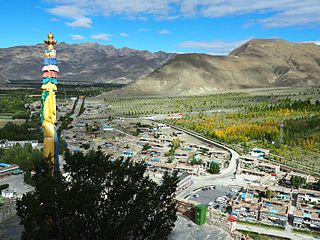
Shannan, also transliterated from Tibetan as Lhoka, is a prefecture-level city in the southeastern Tibet Autonomous Region, China. Shannan includes Gonggar County within its jurisdiction with Gongkar Chö Monastery, Gonggar Dzong, and Gonggar Airport all located near Gonggar town.
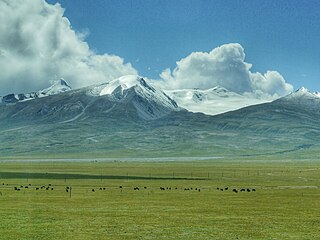
The Nyenchen Tanglha Mountains are a 700-kilometre (430 mi) long mountain range, and subrange of the Transhimalaya System, located in Tibet and the Tibet Autonomous Region of China.
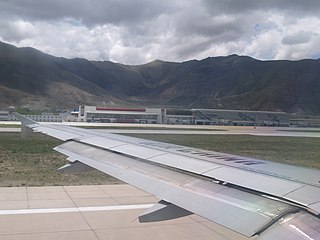
Gonggar County, also Gongkar, is a county of Shannan in the Tibet Autonomous Region, one of the 12 counties of the prefecture. It has under its jurisdiction five towns, three townships, 43 administrative villages and 168 village development committees and contains notable landmarks such as the Gonggar Choide Monastery, the Zhug Dêqên Qoikor Monastery, Gangdoi Town, the Gonggar Dzong at Xoi, the Lhasa Gonggar Airport at Gyazhugling, the Tubdain Ramai Monastery and the county seat of Gyixung.

The Yarlung Tsangpo, also called Yarlung Zangbo is the upper stream of the Brahmaputra River located in the Tibet Autonomous Region, China. It is the longest river of Tibet and the fifth longest in China. The upper section is also called Dangque Zangbu meaning "Horse River."

The following outline is provided as an overview of and topical guide to Tibet:
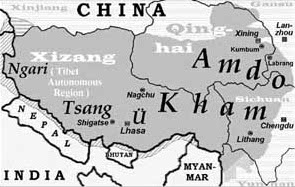
Ü is a geographic division and a historical region in Tibet. Together with Tsang, it forms Central Tibet Ü-Tsang, which is one of the three Tibetan regions or cholka. The other two cholka are Kham (Dotod) and Amdo (Domed). According to a Tibetan saying, "the best religion comes from Ü-Tsang, the best men from Kham, and the best horses from Amdo".
The Zangmu Dam (藏木) is a gravity dam on the Yarlung Zangbo/Brahmaputra River 9 km (5.6 mi) northwest of Gyaca in the Tibet Autonomous Region of China. This dam is built a few kilometers from the Bhutan-India border. The purpose of the dam is hydroelectric power production using run-of-the-river technology. It is part of the Zangmu Hydropower Project and supports a 510 MW power station. Construction began in 2009 and the first generator was commissioned in November 2014. The last became operational on 13 October 2015. It is the first dam on the Brahmaputra/Yarlung Zangbo River and has caused controversy in India.
The Pangduo Hydro Power Station is a reservoir and dam on the Lhasa River in Lhünzhub County to the east of Lhasa, Tibet Autonomous Region, China. The primary purposes are hydroelectric power generation and agricultural irrigation. Work started in 2008. The first turbine came into production in 2013 and the other three turbines in 2014. With annual generation capacity of 599 million kilowatt hours, it has been called the "Tibetan Three Gorges". Nevertheless, the comparison is hyperbole since the dam is only able to impound less than 1/30th that of Three Gorges.(31.9 vs 0.97 million acre-feet).
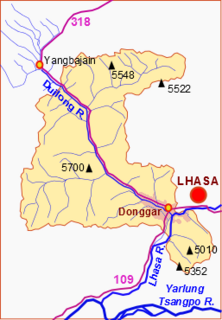
The Duilong River, or Duilong Qu, is a right tributary of the Lhasa River, which it enters just below the city of Lhasa, Tibet, China. The river is about 137 kilometres (85 mi) in length. Water quality may be compromised by dissolved substances including arsenic from geothermal springs.
The Yamdrok Hydropower Station, also known as the Yamdrok Yumtso or Yamzhog Yumcog hydropower station, is a hydroelectric power station just north of Yamdrok Lake, about 16 km (9.9 mi) southwest of Qüxü. The power station is in the Lhoka (Shannan) Prefecture of the Tibet Autonomous Region, China. Opposition to using the lake, considered holy, delayed construction at first. The project ran into difficulties and was two years late, completed in 1998.

The Pengbo River is a tributary of the Lhasa River that runs through the western part of Lhünzhub County, Lhasa municipality, Tibet, China.

Lhasa is a prefecture-level city, one of the main administrative divisions of the Tibet Autonomous Region of China. It covers an area of 29,274 square kilometres (11,303 sq mi) of rugged and sparsely populated terrain. Its capital and largest city is Lhasa, with around 300,000 residents, which mostly corresponds with the administrative Chengguan District, while its suburbs extend into Doilungdêqên District and Dagzê District. The consolidated prefecture-level city contains additional five, mostly rural, counties.

The Yarlung Tsangpo arid steppe ecoregion covers the river valley of the Yarlung Tsangpo River on the southern edge of Tibet. The river runs parallel to the northern borders of Nepal, Bhutan and India, between the Himalayas to the south and the Tibet Plateau to the north. The river valleys are the most populated areas of Tibet, putting pressure on wildlife. The area ranges from cold desert in the west to steppe shrub land in the east; the few trees are in the lowest river valleys to the east.
